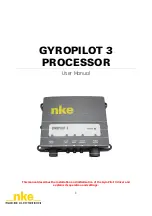
10
3.3.1.
Results of the rudder initialisation
Once initialisation has been completed, the autopilot sends the status of the rudder
initialisation to the displays
If the initialisation has been successfully completed,
•
The measured rudder-stop information and rotation speed are displayed
•
The LED of the rudder angle sensor lights up in green
•
The autopilot changes the rudder angle status to "valid" and the autopilot becomes
operational.
If the procedure is invalid
•
The display will show: "Invalid rudder initialisation".
•
The LED of the rudder angle sensor will remain orange
•
The autopilot sets the rudder angle status to "invalid" and the autopilot remains
disabled.
In the case of an invalid procedure, the whole procedure must be carried out again. Rudder
initialisation can be considered invalid in the following cases:
•
The rudder angle sensor sends incorrect or missing information. The rudder angle
sensor is immediately discarded and the rudder initialisation fails.
•
The starboard and port rudder stops are within 4 degrees of each other. The
amplitude of the rudder crosshead is too small for optimal use.
•
The zero of the rudder is outside the range [starboard rudder stop, port rudder stop]
(rudder stops have the same sign). In this case the initialisation procedure fails.
•
The hydraulic ram cannot move the rudder faster than 0.2°/s. In this case, it considers
that the hydraulic ram is not responsive enough and that the autopilot cannot be used
efficiently.
3.4.
PILOT SPEED REFERENCE
The speed used by the autopilot can result from different possible sources: GPS,
nke
SPEEDO. These elements provide the true speed and/or the ground speed of the boat.
Based on all this information, it calculates the autopilot speed which is the boat speed data
that the autopilot will consider. For the GyroPilot 3, the speed used by the autopilot is only a
selection of the speed source (ground or surface) chosen by the skipper via a
nke
display.









































